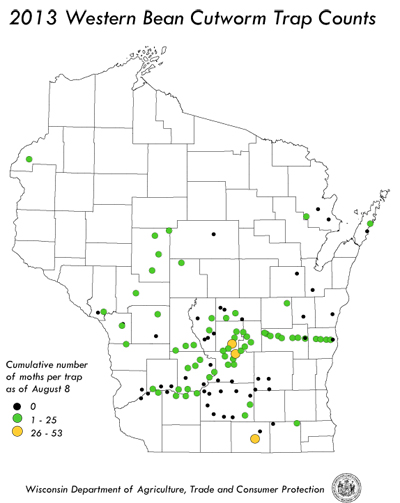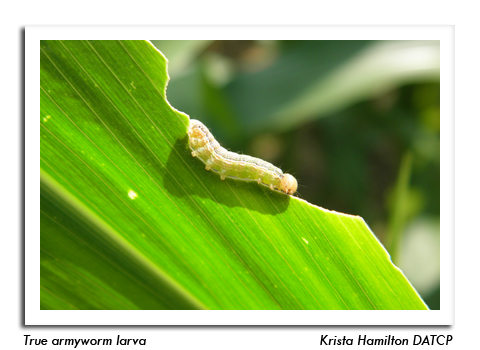
 |
|
|
Corn
Volume 58 Number 14 Date 08/08/2013 WESTERN BEAN CUTWORM - The western bean cutworm degree day model indicates that 75% or more of the adult population has emerged as far north as Hancock in Waushara County. Moth counts have begun to decline across the southern half of the state. By contrast, emergence is about 50% complete in the north-central and northeastern counties where activity appears to have peaked in the past week. The high count for the period of July 28-August 7 was only 17 moths in the pheromone traps near Montello in Marquette County, Neillsville in Clark County and Egg Harbor in Door County. The cumulative state count to date is only 546 moths in 116 traps, the lowest total in the last several years. CORN ROOTWORM - The annual beetle survey is now in progress and preliminary results show population reductions in the southwest and southeast districts. The average count in the southwest is 0.6 per plant, a decrease from 0.8 per plant in 2012. In the southeast, the district average of 0.3 per plant compares to 0.9 per plant last year. Despite lower beetle populations in portions of the south, counts in individual fields are as high as 5.6 per plant. Late-planted corn will remain at risk of silk pruning throughout August and should be checked to ensure pollination is not being impaired. EUROPEAN CORN BORER - Moths of the second flight continue to appear in very low numbers in black light traps, signaling that eggs are being deposited on corn and other hosts. The peak of summer moth activity is expected to occur in southern and central Wisconsin by August 19. Sweet corn and non-Bt field corn should be inspected for egg masses and larvae before 2,100 degree days (base 50°F) are surpassed and the treatment window for second generation corn borers closes. Surveys this week found minor infestations affecting 10-23% of plants in Monroe, Richland and Vernon counties. JAPANESE BEETLE - A DATCP survey specialist reports that approximately 3-4% of the plants in a Monroe County field had silks pruned to the ear tip and as many as five beetles per plant were feeding on the silks, potentially impairing pollination. Silk pruning was also noted in scattered fields in Grant, Lafayette and Sauk counties. Control of this pest is warranted for populations that exceed three beetles per ear when pollination is incomplete. TRUE ARMYWORM - Larvae produced by large moth flights last month are appearing in corn. Surveys during the first week of August found infestations affecting 2-14% of plants in several Juneau, La Crosse and Monroe County fields, with larvae ranging from 1-1½ inches in length. Severe armyworm problems are uncommon at this time of year, but their prevalence suggests continued scouting is in order. The last significant outbreak of second generation armyworms was in August of 2005. -- Krista Hamilton, DATCP Entomologist 





|
|
|